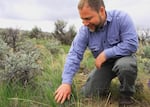
Jay Kerby with the Nature Conservancy shows some healthy fronds of bluebunch wheatgrass. After fire, Oregon's native grasses are slower to re-establish in desert habitats. Kerby and his team are researching ways to improve seedling survival rates so invasive species don't push out desert grasses.
Amanda Peacher / OPB
Researchers in the Eastern Oregon Agricultural Research Center in Burns have been working on how to successfully reseed grasslands with indigenous grasses. These desert areas are frequently subject to fires, which wipe out native grasses. In their place invasive, non-native grasses spring up, inexorably pushing out the naturally adapted grasses.
Ecologist Jay Kerby with The Nature Conservancy, which is partnering with the Ag Center, says millions of dollars have been spent — largely unsuccessfully — trying to reseed these lands after fires. Now researchers think they've had a breakthrough creating "seed pillows" using commercial pasta machines and doughnut makers. These seed pillows combine multiple seeds in an earthy, compost-rich mixture. Tests reveal the seed pillows successfully germinate more often than seeds planted alone.
We talk with Kerby about this marriage of culinary and agricultural technology and its potential to transform restoration efforts.
